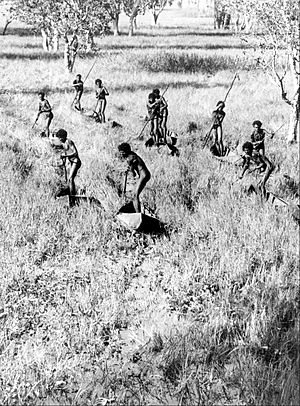Arafura Swamp facts for kids
The Arafura Swamp is a huge freshwater wetland in Arnhem Land, located in the Top End of the Northern Territory of Australia. It's a very natural floodplain that covers about 700 square kilometres (270 sq mi). This area can grow to 1,300 square kilometres (500 sq mi) during the wet season. This makes it the largest wooded swamp in the Northern Territory, and maybe all of Australia! The amount of water in the swamp changes a lot with the seasons.
This area is very important to the Yolŋu people, especially the Ramingining community. The famous Australian film Ten Canoes was even filmed here.
Where is the Arafura Swamp?
The Arafura Swamp is a big, uneven floodplain surrounded by a low plateau that is 60–100 metres (200–330 ft) high. There are steep cliffs, called scarps, to the east and west. The eastern cliffs include a place called the Arafura Jungles.
The swamp has many small rivers and billabongs (waterholes). It helps control floods and collects mud for the Goyder-Glyde river system. The main rivers flowing into the swamp are the Goyder and Gulbuwangay Rivers from the south. Water then flows north through the Glyde River into the Arafura Sea.
The area has a monsoonal tropical savanna climate. This means it has a wet season and a dry season. It gets over 1,000 millimetres (39 in) of rain each year, mostly from December to April. In dry years, much of the swamp might not have standing water during the dry season. During the wet season, the water depth increases by almost two metres. The swamp starts refilling in January and is deepest in April.
Animals and Plants of the Swamp
The Arafura Swamp is home to 25 different plant groups. Over 100 types of grasses, herbs, aquatics, sedges, and trees have been found here. Most of the swamp is covered by low forest and woodland with grassland. The most common trees are the paperbarks, known as Melaleuca cajuputi and Melaleuca leucadendra.
The swamp is known as an Important Bird Area. It's a major place where magpie geese come to breed. Many other waterbirds also live here, like wandering whistling ducks, Pacific black ducks, and green pygmy geese. There are also breeding groups of royal spoonbills, little pied and little black cormorants, and darters. The land next to the swamp has one of the biggest groups of hooded parrots outside the Katherine area.
Large numbers of fruit bats eat and rest in the huge paperbark forests. A type of fish called the threadfin rainbowfish was found here, even though it was only known from New Guinea and the Cape York Peninsula before. The swamp is also an important place for freshwater and saltwater crocodiles to breed.
How People Use the Swamp
Aboriginal people from the Ramingining community use the swamp for fishing, hunting, and gathering food. This includes collecting the eggs of geese and crocodiles. The edges of the swamp are also used for grazing livestock.
The Arafura Swamp is one of the few tropical wetlands in Australia still managed by Aboriginal people. They use traditional ways of managing the land, including special burning practices. An anthropologist named Donald Thomson studied how people traditionally used the swamp in the 1930s. A lot of the 2006 film Ten Canoes was filmed right here in the swamp. Many of the actors were from the local community and spoke in Yolŋu Matha.
The swamp is Aboriginal freehold land, which means it is owned by the Arnhem Land Aboriginal Land Trust. The Arafura wetlands, along with the area that collects its water (catchment), were once listed on the now-closed Register of the National Estate.


